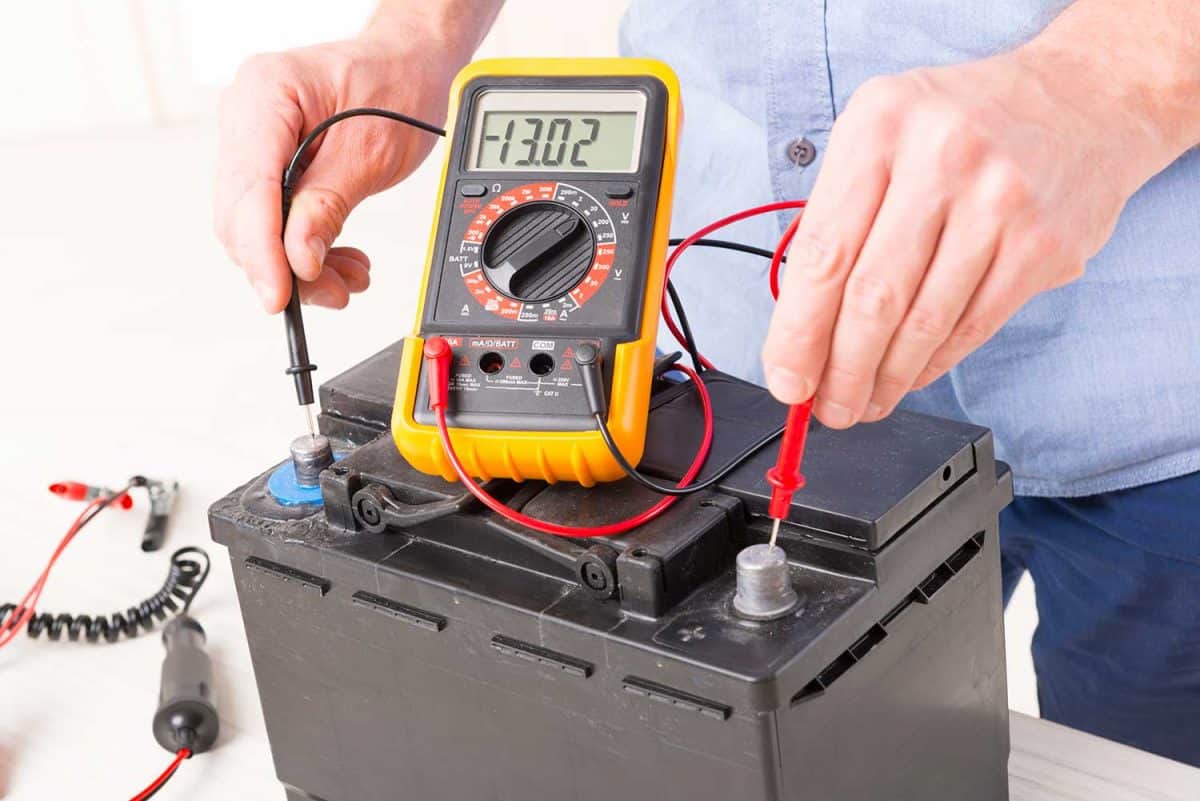A deep cycle battery is designed to provide power for long periods of time. Although they are capable of sustaining power better than regular batteries, temperature changes still affect them. It's common knowledge that hot weather conditions kill batteries. But when the weather gets too cold, the freezing damages the battery too. We did in-depth research on what happens when a deep cycle battery freezes. Here's what we found.
Freezing can cause a deep cycle battery to become non-functional. Once freezing occurs, the battery could crack due to the expanding water, causing it to leak its acidic contents. Should that happen, call a professional to check your battery and replace it if need be.
Keeping your deep cycle batteries fully charged can help prevent them from freezing. Read through to know more about what causes these batteries to freeze, how to prevent that from happening, and what you can do to restore them.
NOTE: WE MAY GET A COMMISSION IF YOU DECIDE TO MAKE A PURCHASE THROUGH THESE LINKS. THERE'S ADDITIONAL NO COST TO YOU. CHECK THE BOTTOM OF THE PAGE FOR MORE INFORMATION.

What Causes A Deep Cycle Battery To Freeze?
A deep cycle battery that is low on charge makes it exposed to freezing, which is due to the battery's freezing point increasing. A discharged battery's electrolytes then become water-like. Given that water's freezing point is higher than other liquids when the battery's solution reaches a water-like state, it becomes more prone to freezing.
Compared to other lead-acid batteries, a deep cycle battery can have a depth of discharge as high as 80 percent. It is possible because their design allows them to go through regular charge and discharge cycles without ruining the battery because of its thicker plates. Discharging a deep cycle battery at the required depth, and charging it only once it reaches this point, regulates its condition. But as a result of this cycle, the battery is at higher risk of freezing when exposed to colder weather. Once it freezes, the battery will stop functioning.
Can A Fully Charged Battery Freeze?
A deep cycle battery is a type of lead-acid battery, usually containing sulfuric acid and water. The combination is known as the battery's electrolyte.
A fully charged battery has more sulfuric acid than that of a discharged one. Sulfuric acid freezes at a lower temperature, and so lowers the freezing point for the fully charged battery. Sulfuric acid is depleted in discharged "empty" batteries, making them more prone to freezing.
A battery can still freeze even when it's fully charged. The difference between these and discharged ones is their freezing points.
A fully charged battery has a higher concentration of sulfuric acid because charging drives sulfate in the battery back to acid. With more sulfuric acid, the freezing point goes down to as low as -70 degrees Fahrenheit. And so, it takes a long while for the battery to become frozen, making it appear as though it cannot freeze at all.
How Long Does It Take For A Frozen Battery To Thaw?
Thawing a frozen battery will depend on the temperature of the room or area. When left at room temperature, it takes a couple of hours, usually 2 to 12 hours, depending on how frozen it is. With the presence of heat, it could take a few minutes to a few hours. During wintertime, despite snow melting, the battery cannot thaw if the temperature is lower than its freezing point.
Inspect the battery before thawing to make sure the case has no cracks. The water inside the battery turns into ice, causing expansions that damage the case. If the battery's case is damaged, battery acid may spill and cause burns. You might need to call for professional help with thawing it in this situation.
Can You bring A Deep Cycle Battery Back To Life?
When a deep cycle battery reaches its peak, you might start considering getting a new one. Depending on why it wore out, the battery may still be usable for a few more years. A deep cycle battery is restorable as long as the complications are not caused by severe damages. You can revive it by following the step below.
Remember to wear protective gear such as safety goggles, and gloves. Battery acid is harmful and capable of burning the skin or causing respiratory complications. Be sure you have proper protection before you begin the restoration.
1. Read the Battery's Current Charge
Use a load tester to get an overview of your battery's condition. Load testers will measure how much amperes your battery can produce, which determines whether it is capable of starting an engine or not. You'll be able to see how weak your battery has gotten based on where the dial lands.
2. Make Sure The Battery Is Clean
Batteries experience corrosion as they age, producing a white powder-like substance on the battery. Note that these are toxic, so try to avoid direct contact with them as much as possible. Cleaning them off requires a mixture of water and baking powder, which neutralizes the acid to make it harmless. You can add soap to the solution to clean off dirt and grease with it. Be sure you are thoroughly cleaning and drying the battery, its clamps, and its terminals.
3. Detach the Battery's Cell Lid
The battery cell caps are removable by twisting them. You will have to use a screwdriver or a needle nose-peril to take off the lids. Prevent dirt from getting into the battery cells as much as possible. When you take the caps off, have a towel or rag with you to wipe off any dirt and debris around the battery cell.
Prepare a container as well in case you would need to remove the acid inside of the battery. Be extra careful with pouring out the liquid and how you will be exposing the battery acid.
4. Fill the Battery Cells With Water
It's crucial to be sure you're using clean distilled water. Other forms of water, such as tap or purified, may contain minerals that could cause corrosion inside the battery. To clean the inside of the cells, you can mix the distilled water with baking soda.
Pour the distilled water into each of the battery cells completely. Be wary of how much you are pouring as overfilling it could cause remaining acids to come out. The amount of water required for each cell depends on the battery's size and acid levels.
If you're looking to use the Epsom salt method as well, create a new solution. Heated distilled water will make it easier for the salt to dissolve. Before you pour the new solution, put the lids back on and shake the battery for a few seconds. Take off the caps and pour out the first solution into a bin. Afterward, you can fill each cell with your new mixture.
5. Connect The Battery to a Charger
Let the battery slow charge for 24 hours with a regular battery charger. Note that putting the battery cell lids on can cause overflow while it charges, so it would be best to keep them off during the charging phase. Check the volt reading once the 24 hours are up.
If the battery charger fails to revive the battery, you may need to purchase a battery resuscitator. The device will pulsate power through the battery's plates resulting in the sulfates breaking. After removing the sulfate, attempt to charge your battery again.
6. Test the Voltage

Read your battery's voltage after the charge. You can do a load test to see how much it improved compared to the initial state. Doing these is enough to make your battery usable, but to increase the battery's CCA, proceed to the next step.
7. Do A Cycle and Full Charge
Cycling a battery is to drain it then fully charge it again. Wait for the deep cycle battery to discharge as low as 10 volts before giving it another full charge. After wiping off any liquid on the surface, check the battery's voltage and conduct another load test.
Are Battery Blankets Worth It?
When you're living in a state where weather conditions can go extremely low, purchasing a battery blanket will surely be worth your money. It's good to have one just in case too.
A battery warmer is an insulated blanket that you can wrap around your battery. This usually comes with a power cord to heat the blanket. It makes a big difference during cold weather since it prevents the battery from reaching its freezing point, especially when discharged.
Some batteries, however, won't charge unless it reaches a specific temperature. With a cold battery, the blanket will help you achieve this temperature before it completely freezes. But warm batteries may go beyond the needed temperature, which may prevent them from getting the charge they require.
An Overview
Deep cycle batteries can go through over a hundred cycles without getting damaged. However, the requirement of discharging it makes it likely to freeze in cold weather, hence prone to cease functioning. Discharged batteries have less sulfuric acid, therefore, having a consistency like water. Freezing occurs when the temperature drops enough to reach the battery's freezing point at this state. Regardless, restoring the battery is still possible. There are methods to keep them warm, such as with the help of a battery blanket.



